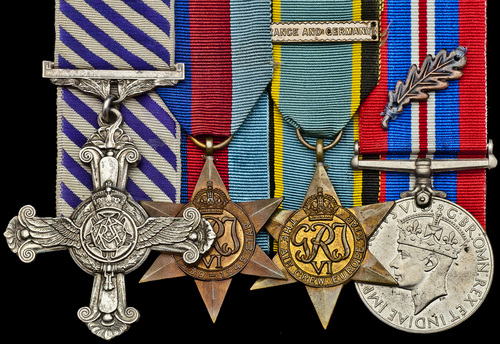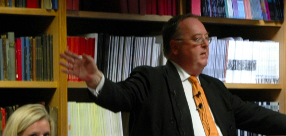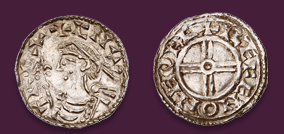
Auction: 15002 - Orders, Decorations, Campaign Medals and Militaria
Lot: 18
A Particularly Fine Second War 1943 'Immediate' Sterling and Flying Fortress Rear Gunner's D.F.C. Group of Four to Gunnery Leader, Flight Lieutenant E. J. 'Phil' Phillips, Royal Air Force Volunteer Reserve, He Flew in At Least 51 Operational Sorties; Was Severely Wounded Whilst Engaging An Enemy Fighter Over Essen, 25/26.7.1943; Shot Down a M.E. 410 During D-Day Operations, 5/6.6.1944, And Was Employed in Special Duties For Operation Market Garden
a) Distinguished Flying Cross, G.VI.R., reverse officially dated '1943'
b) 1939-1945 Star
c) Air Crew Europe, with France and Germany Bar
d) War Medal, M.I.D. Oak Leaf, generally very fine or better, mounted for display, with R.A.F. Observer's and Air Gunner's Flying Log Book (29.8.1942-4.5.1945), and a comprehensive file of copied research (lot)
D.F.C. London Gazette 15.10.1943 Flying Officer Eric John Phillips (130236), Royal Air Force Volunteer Reserve,15 Squadron [jointly listed with Pilot Officer G.W. Gabel (Can./J.17528), R.C.A.F., 15 Squadron]
'One night in July, 1943, these officers were rear gunner and pilot respectively of an aircraft detailed to attack a target in the Ruhr. During the operation the aircraft was hit by cannon fire from a fighter. The rear turret was rendered unserviceable and Flying Officer Phillips was wounded in the face and chest. One of the bomber's engines had caught fire and Pilot Officer Gabel tried to feather the propeller. He was unable to do so, however, and the situation became serious. Suddenly the propeller fell away and the flames in the burning engine died away. Displaying great skill and tenacity, Pilot Officer Gabel battled on to eventually reach base. In spite of his injuries, Flying Officer Phillips displayed great fortitude and devotion to duty and remained on watch in the astro-hatch throughout the return flight.
On a later occasion Pilot Officer Gabel flew his aircraft from Turin with one engine useless. This officer has displayed skill, and courage and coolness of a high order.'
The Recommendation, dated 17.9.43, states: 'Flying Officer Phillips was the rear gunner in P/O Gabel's crew. He has successfully completed fifteen operational sorties, totalling 64.20 hours, including such targets as Essen, Hamburg and Cologne. On the night of 25/26th July 1943, his aircraft was over Essen when it was attacked by an enemy fighter, which put the starboard outer engine out of action and holed the petrol tank in the starboard wing. P/O Phillips opened fire at 200 yards and his tracer either hit the enemy aircraft, or passed very close to it. Almost immediately a high explosive cannon shell hit the turret, pierced the armour plating, put all four guns out of action, and wounded the gunner in the face and chest. When he realised that his guns were useless, his turret doors blown off and his inter-com and oxygen were out of action, he managed to crawl out of the turret, and was then discovered by the Wireless Operator unconscious. First aid was rendered by the Wireless Operator and P/O Phillips then returned to his turret, put his guns at safe, and stood watch in the astro-hatch for the whole of the journey home.
This conspicuous devotion to duty has proved a splendid example to other gunners on the Squadron, and his is strongly recommended for above award.'
M.I.D. London Gazette 1.1.1946 Acting Flight Lieutenant E.J. Phillips, D.F.C (130236), R.A.F.V.R.
Flight Lieutenant Eric John Phillips, D.F.C., initially served as a Leading Aircraftsman with the Royal Air Force Volunteer Reserve during the Second War; trained as an Air Gunner, at No.1 A.A.S., R.A.F. Manby, from August 1942; after further training at No.26 O.T.U., 1483 Gunnery Flight Marham and 1651 Conversion Unit, Waterbeach, he was posted for operational flying to 15 Squadron (Stirlings), Mildenhall, Suffolk, April 1943; he flew in 18 operational sorties with the Squadron, including: Duisburg (2); Bay of Biscay; Bochum; Dortmund; Dusseldorf (2); Wupertal (2); Le Creusot; Krefeld; Mulheim; Gelsenkirchen; Cologne; Hamburg; Essen, 25/26th.7.1943 (see D.F.C. Recommendation); Cattegat and Frankfurt; after a posting to A.F.D.U. Newmarket he returned to operational flying with 214 (Federated Malay States) Squadron (Fortresses), Oulton, Norfolk, April 1944; as part of 100 (Bomber Support) Group the Squadron was equipped with American Flying Fortress Aircraft and was employed on Special Duties, especially radio counter-measures, the detection and jamming of enemy radio and radar equipment; he flew in 33 operational sorties with the Squadron, including: Keil (2); Trappes; D-Day, 5/6.6.1944, 'Ops. Special Duty Patrol For Invasion. Shot Down M.E.410' (Log Book refers), with Wing Commander McGlinn as his pilot; Martin Bowman's 100 Group (Bomber Support) R.A.F. Bomber Command in World War Two gives the following, 'On 5/6 June, a Mandrel screen was formed to cover the approach of the Normandy invasion fleet and from subsequent information received, it appeared that considerable confusion was caused to the German early warning system... Five Fortresses of 214 Squadron flown by the CO, Desmond J. McGlinn D.F.C., and Squadron Leaders Bill Day and Jefferies... Flight Lieutenant Murray Peden R.C.A.F. and Flying Officer Cam Lye R.N.Z.A.F., also operated in support of the D-Day operation in their Airbourne Cigar (ABC) role... Eric 'Phil' Phillips, the Squadron Gunnery Leader, manning the tail turret of McGlinn's Fortress, also shot down an M.E. 410.'
Peden added the following details of Phillip's action in his book A Thousand Shall Fall, 'After six hours and 25 minutes in the air we landed at Oulton, and shortly made our way up to the parachute section, and then interrogation. When we had finished a particularly detailed questioning on our participation, I glanced around the room to see if I could see the Wingco [McGlinn]. I knew he was back; I had enquired and the WAAF driving the crew bus had told me that everyone was back. I asked the Intelligence Officer where the Wingco was.
"Oh, didn't you hear?" he said in surprise; "they shot down a fighter, a Messerschmitt 410. The Wingco and his crew are throwing a party in the mess."
"What do you mean?," I said, not sure that I fully understood.
"Right now, they're at it now!" he laughed. "They were so tickled at getting the fighter, they left a few minutes early and came home like a shot. Beat all the rest of you here."
Since the commoner result by far in these grossly unequal night combats was the loss of the bomber and its whole crew, we too considered that the occasion warranted a celebration, particularly since it flowed directly from the launching of our long awaited invasion. I wondered if the German night fighter had been the one whose con trails we had spotted. By the fortunes of war he had not picked the easiest target in the area. Any of the Lancasters, with their light .303 calibre armament, would have been less prickly targets than a Fortress, with its point fives and extra gun positions; and of the five Fortresses he had found the one with the squadron Gunnery Leader [Phillips] manning the tail turret.'
He continued with his second tour with operations to St Valery; St. Leu O'Esserent; Chalons Sur Marne; Le Havre; Stuttgart; Hamburg (3); Stettin; flew in two 'Special Duties Over Holland' operations in the lead up to and as part of Operation Market Garden, 10.9.1944 and 19.9.1944 respectively; Munster (2); Nuremburg; Frankfurt (3); Cologne (2); Mannheim; Merseburgh; Opladen; Osterfeld; Karlsruhe; Neuss; Dortmund Emms Canal; Dusseldorf; Pilsen; Komotau and Schleswig-Jagel; he completed his second tour of operations in May 1945 and was recommended for Green Endorsement.
Subject to 20% VAT on Buyer’s Premium. For more information please view Terms and Conditions for Buyers.
Estimate
£2,200 to £2,600




